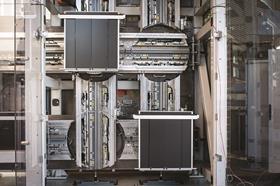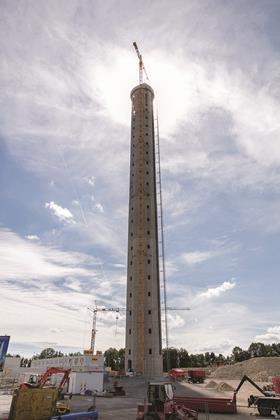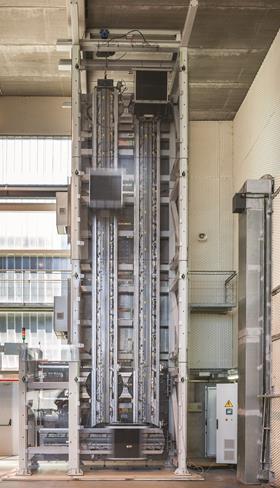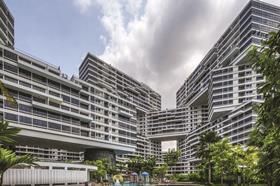ThyssenKrupp has come up with a lift that not only functions without cables, but is also able to move horizontally as well as vertically. So what might this mean for the future of building design?

Since the modern passenger lift was invented 163 years ago, lift technology has stayed pretty much the same. The introduction of the lift revolutionised not just architectural design but the planning of our towns and cities by laying the foundations for the skyscraper and ushering in an age of high-density urbanism.
Today the common lift is one of the safest and most ubiquitous forms of transport in the world, so much so that it is easy to take its enormous significance for granted. There are an estimated 12 billion lifts on earth with around 20% of the world’s population using a lift every day. But to all intents and purposes the lifts we travel in today are still using the same core technological principles Elisha Otis first patented in New York back in 1852.
Until now. Multinational components manufacturer ThyssenKrupp has unveiled a new lift system which it claims will be the most revolutionary development in lift technology since the lift itself was invented. The Multi system is significant for three main reasons. First, it is the first lift system to be developed that is entirely cable free. Secondly, it can operate with multiple lifts in any one shaft. And thirdly and perhaps most radically, the lift can move horizontally as well as vertically.
All three features open up a tantalising plethora of new design, structural, commercial and even urban possibilities for mid and high-rise buildings. If lifts can move in a horizontal direction, then perhaps building envelopes can mimic this, creating a dynamic new architectural language that abandons the traditional idea of isolated single-core vertical buildings and introduces the intriguing possibility of mega-structures linked in the sky. Ironically, such developments would not be entirely dissimilar to the illusionistic imagery that defined the visionary expressionist and futurist movements of the early 20th century and spawned film classics such as Metropolis.
But it is not just architectural form that has been the driving force behind this new technology but also more tangible practical and commercial concerns. By placing several lift cars into single shafts and opening the possibility of lift cars moving horizontally between separate shafts, Multi claims to increase a building’s usable area by up to 25% while increasing shaft transport capacity by up to 50%. These statistics easily translate into construction cost savings, increased rent revenues and greater availability of usable space.

Urbanisation
There is also an important urban dimension. Some have estimated that an additional 85% of existing urban and commercial floor space will be required by 2025 to accommodate an increased global population. Additionally, the Council on Tall Buildings and Urban Habitat (CTBUH) has calculated that since the year 2000, there has been an astonishing 318% increase in tall building construction with the average height of the world’s 50 tallest buildings rising by 25% in the past decade alone.
While the popular supposition that tall buildings are the best means to deliver high-density is hotly disputed and has been widely debunked by various academic sources in favour of mid-rise development, tall buildings remain the most popular global means of accommodating a spiralling population.
Yet while construction technology means that buildings can now get taller and taller, their functionality is severely constrained by reliance on a central core lift-shaft system that is still largely based on moving a limited set of people in one direction at any one time. This method creates capacity bottlenecks, increases passenger waiting times and reduces movement efficiency with common lift and escalator footprints assuming up to 40% of total tall building floor space.
Of course there have been various solutions that have aimed to address these limitations. The introduction of express and double-decker lifts has helped increase efficiency marginally and ThyssenKrupp itself was responsible for the TWIN lift system which enables two cars to run in a single shaft. The paternoster lift system has been another alternative where a continuously moving open lift car allows passengers to jump in and out. Whilst beloved of students and revellers, paternosters have been consistently dogged by safety concerns and are notoriously slow, reaching glacial speeds of 0.25m/s.
Speed has been the other remedy commonly prescribed to cure lift shaft inefficiencies with lifts in the Guangzhou CTF Financial Centre set to reach dizzying speeds of 20m/s of when it opens next year, the world’s fastest ever lift.
But there are severe limitations to indefinitely increasing the speed of lifts. The human body experiences heightened sensation and a greater propensity towards discomfort when lift speeds approach or exceed 10m/s, as building managers at Chicago’s Willis Tower, for decades the world’s tallest, were reluctantly forced to concede when tenant complaints compelled them to halve the speed of the building’s lifts from 8 to 4m/s.
Additionally lifts cannot constantly maintain high speeds because they eventually have to slow down to serve floors. Or in the words of Dario Trabucco, CTBUH research fellow and professor of building technology at the Venice school of architecture, “even a Ferrari has to stop at traffic lights”.

Technology
So how does the Multi system work? Ironically it combines the low-tech of the paternoster system with the high-tech of Maglev train technology. Its basic premise is a circular rotational system that shunts multiple lift cars from a vertical to a horizontal position across a mechanical interchange, similar to railway tracks.
Additionally, lift cars are not secured to the shaft by the traditional means of cables and counterweights but by magnetic yokes connected to a linear drive system.
To all intents and purposes this linear drive system resembles stainless steel railway tracks that are configured in both horizontal and vertical positions, or what ThyssenKrupp engineers like to refer to as “verizontal”. These tracks extend the full height of the shaft and are fully contactless, using linear induction motors to provide the propulsion that drives lift car motion.
The linear drive then supports a sledge onto which the lift car itself is finally fixed. The sledge incorporates the coil units and magnetic yokes that are driven by the induction motor and move the lift. So it is the sledge that essentially undertakes the role that would be traditionally assumed by cables and counterweights.
The next key feature of the Multi system, its horizontal movement, is handled by a series of vertical swivel platforms. These swivel platforms are known as “exchangers” and they are located at interchange junctions where a vertical shaft meets a horizontal one. The platforms resemble turning circles and they rotate the sledge into a horizontal position, thereby shifting the orientation of travel while keeping the lift in an upright position.
In order to achieve the propulsion required for the system to work and to minimise loading onto the linear drive and the exchangers, the lift cars are kept as light as possible. Rather than conventional steel construction, they are constructed from carbon fibre walls and a lightweight aluminium frame. The result is an average weight of 50kg rather than the 300kg of a conventional lift car.
Additionally, the linear drive and the absence of counterweights allows smaller lift shafts, as small as a mere 6m². This of course reduces core footprints which converts into construction cost savings and increased lettable area. The system also offers the capacity to digitise lift transport with predictive maintenance technologies and user interface capability responding to demand and alleviating bottlenecks. Safety is assured by detectors that prevent lifts colliding and by manual and automated fault locking overrides.
Thus far ThyssenKrupp has constructed a 1:3 prototype of the system at its factory in Gijón, northern Spain. However, a full-scale mock-up is being built at a 241m high tower in Rottweil, Germany, an extraordinarily ambitious test structure taller than London’s Leadenhall Building. The system is expected to be commercially available some time after the completion of this tower next year.

Impact
So what impact could this radical lift system have on both the construction market and architectural design? According to Trabucco, it could be huge. “For decades, skyscrapers have been defined by the limitations of lift shaft technology - you only need to look at the set-backs and indentations on the Empire State Building to see how lift shafts and transfer structures influenced high-rise architecture in the 20th century.
“But this new system offers the possibility of architectural form no longer being constrained by vertical cores as well as the practical benefits presented by higher net ratios, smaller core footprints and greater movement efficiency.”
In many ways, current architectural design has already pre-empted the new horizontal connections suggested by Multi. Back in 1996 the Petronas Towers were the first to incorporate a direct vertical connection between two high-rise buildings but the theme has been enthusiastically sustained by more recent buildings such as Marina Bay Sands in Singapore, Beijing’s Linked Hybrid and CCTV Buildings and Singapore’s Interlace complex. “These buildings demonstrate that architectural design is […] introducing high-level connections that challenge the traditional notion of a single vertical core,” continues Trabucco. “This new system can see that level of architectural exploration matched by functional technological advancements.”
WSP, structural engineers for the Shard and several other high-rise projects across the world, are broadly welcoming of the new technology as Kamran Moazami, head of discipline and the firm’s building structures division, explains. “It’s a great system for taller commercial buildings where the demand for the number of lift increases. The main attraction is the ability of going both horizontal and vertical for buildings with setbacks. For example, if a building is tapered like the Leadenhall Building, lifts could be placed anywhere.”
But both Moazami and his colleague Steven Truss, WSP technical director of vertical transportation also have reservations. Moazami struggles to see any clear advantages with residential buildings where lift space is limited. And Truss suspects that deployment of this kind of new technology might be restrictive.
“As this product is currently only offered by one manufacturer you’d effectively have to design the building around it. Also, although the smaller lift shafts are cited as a commercial advantage, using this system would require an incredibly bold purchasing decision right at the start of the project as it would be impossible to retrofit larger lifts into smaller shafts.”
Like all new technology, the Multi system faces an uphill struggle. But it clearly also has the potential to spark the biggest technological revolution in the design of high-rise buildings since the invention of the lift itself.
A short history of lifts
236 BC: Roman architect Vitruvius reports that mathematician Archimedes has constructed a lift-like contraption
Late 17th century: Louis XIV and William III install lift-like prototypes at the palaces of Versailles and Hampton Court
1793: First “screw-drive” lift installed in Winter Palace in St Petersburg
1830s: Hydraulic and steam powered lifts developed in England
1852: US industrialist Elisha Otis invents safety lift, foreshadowing modern lift technology and ushering in the age of the skyscraper
1857: Otis installs world’s first passenger lift in New York’s five-storey Haughwout Building
1868: Architect Peter Ellis installs world’s first paternoster lift in Oriel Chambers, Liverpool
1870: Equitable Life Building in New York is the first office building to use passenger lifts
1880: German industrialist Werner von Siemens invents world’s first electrically powered lift
1907: First patent secured for multi-car single lift shafts (unrealised until 2003 below)
1924: World’s first express lifts installed in New York’s Woolworth Building, then world’s tallest
1931: Stepped silhouette of Empire State Building indicates high-rise architecture now being defined by lift shaft construction
1976: At a speed of 6.5m/s, London’s 99 Bishopsgate Tower has fastest lifts in Europe
1979: UK’s first double-decker lifts installed at NatWest Tower
1986: UK’s first external scenic glass lifts installed at Lloyds Building
1993: Basement bomb in World Trade Centre forces occupants in upper floors to wait almost five hours for evacuation, igniting global review of lift safety
1994: Germany attempts, unsuccessfully, to ban all paternoster lifts on safety grounds
2003: ThyssenKrupp invents TWIN lift system with two cars in one shaft
2012: 81-year-old man killed by paternoster lift shaft in The Hague
2015: Shanghai Tower unveils world’s fastest lift reaching speeds of 18m/s or 40mph
2015: ThyssenKrupp reveals prototype for world’s first cable-less horizontal lifts




























No comments yet